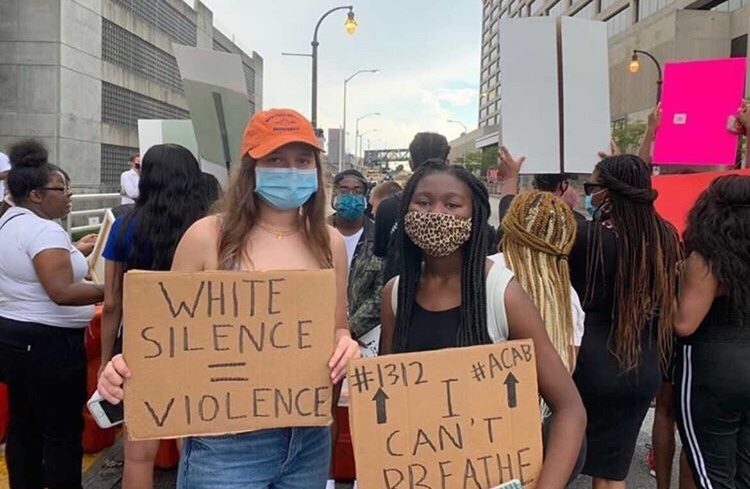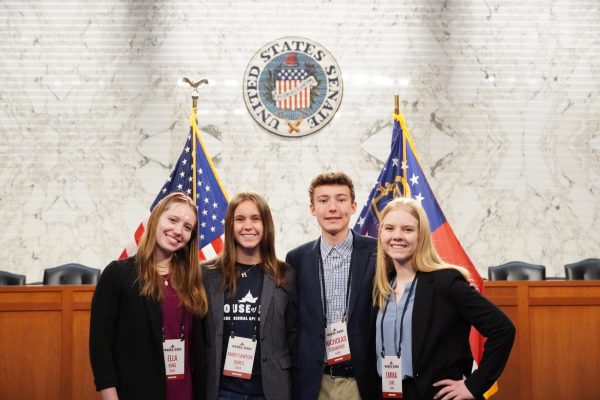Student Activists Respond to Re-Emerging BLM Movement
2020 has undoubtedly been a year of change, from COVID-19 remolding lifestyles to the recent presidential election altering political prospects. On top of that, the reappearance of the Black Lives Matter (BLM) movement has been the main driver for increased social change.
The movement began in 2013 after George Zimmerman shot 17-year-old Trayvon Martin but was declared free of all charges. After the incident, the hashtag #BlackLivesMatter gained prominence along with the movement for change for Black communities in the United States. It has been an on-and-off, though ongoing movement, sparking frequent protests and demonstrations. But over the summer, the death of George Floyd served as a catalyst for the movement’s resurgence in 2020.
Floyd was a 46-year-old Black man accused of paying with a counterfeit bill at a local convenience store in Minneapolis. During the encounter with law enforcement, Floyd explained the medical situation that inhibited him from sitting in the police car to the officers, but they continued to struggle until Floyd fell to the ground. Immediately after, Officer Derek Chauvin knelt on Floyd’s neck for seven minutes and forty-six seconds while Floyd continued to say that he could not breathe. He was declared dead at 9:25 PM that same day.
A Political Glimpse
However, the speculations behind the George Floyd incident did not die down with his death. Floyd’s tragic encounter paved the way for protests in the summer and even extended itself to make appearances in the 2020 presidential election. Political candidates voiced their opinions on systemic racism and relevant questions came up in presidential debates.
Similarly, the movement had an impact on voters in November.
“This whole movement that happened over the summer really affected people of color making them feel like change from the Civil Rights Movement hasn’t improved that much,” said senior Ashley Michel. “People who were rioting were told to vote so that people that really care about them can be in office. So I do think people this year decided to vote because of that reason but also because they knew that the person currently in office is not in their best interests.”
Sophomore Naa Adua Annan shares the same views.
“I think the BLM movement definitely influenced how people voted this year because of the lack of support that the current president showed towards the movement,” said Annan. “Because of the BLM movement, people who hadn’t previously voted in the past made sure to register and vote.”
On the other hand, the movement also gave rise to performative activism as a way of capitalizing on the several accounts of social injustice.
“It’s extremely hard to see people and politicians lose interest in advocating for justice,” said junior Bijou Nsele. “I’ve recently seen white ‘activists’ sell jewelry made of shattered glass and name them after police brutality victims. This uses Black trauma for profit and puts a price on victims’ jewelry to sort of place some type of monetary value on their lives, which is counterproductive and harmful. It’s also taking away money and energy from Black families that need this money for funeral costs etc. The main point of being a BLM ally is to really uplift voices, and this definitely drained those voices.”
Protest Experiences: A Reflection
The return of BLM has sparked protests all over the country, with one of the prime locations for protesting being downtown Atlanta. It often made headlines for its intense and populated protests, which drew hundreds and sometimes thousands of attendees.

Michel recounts her time at a protest downtown that she attended with her mom and sister.
“We first went to Lenox, and everything was boarded up because there were lots of riots and breaking glass, so Lenox was all closed,” said Michel. “There were like army officials, and they were lined up blocking exits. [The army officials] really covered the whole perimeter of Lenox Mall, and after that, we went by Phipps Plaza, and we could see like they were all boarded up as well, all the nice stores—like Gucci and everything.”
This particular protest started out peacefully but became more serious as it got closer to the mandated coronavirus curfew.
“We went downtown, and we parked near the Atlanta Ferris wheel, and we did see military officials like bordering around as well when we got to the center,” said Michel. “That’s when we saw lots of people with their signs and just protesting and marching. [Finally,] we made it to the car because there was a curfew, and we made it to the car like 10 to 20 minutes before the curfew. By the time we like paid for our parking and got out of that area and were trying to drive off, we saw people running, and we heard gunshots.”
Meanwhile, Nsele had a different experience at one of the many Black Lives Matter protests she attended downtown.
“It was peaceful, it was very peaceful,” said Nsele. “People would like, stand up and give speeches and stuff. They would voice their opinions, and they would have certain areas where people would speak up and talk about victims and go on about how they were treated very badly by the system.”
The protest environment was very uplifting for senior Morgan Warfield as well.
“I went to a BLM protest over the summer,” said Warfield. “It was a really eye-opening experience. The protest was out near my church, which is in the country, and I was expecting there to be backlash and criticism from those who see BLM as a hate group or whatever they call it. Surprisingly, the community out there was really supportive. People were passing us water bottles from their driveways and joining the march as well.”
Some students were not able to actively attend protests because of health, safety, and personal concerns, but this did not stop them from contributing to the movement.
“I wasn’t able to [attend the protests] because my family was concerned about COVID, so I just stayed home,” said junior Kamora Kemp. “But I tried to repost things that I found factual and that could be backed up. Like especially at the end [of a social media post] when you swipe, they give sources and all of that. […] I’ve also tried to do more research on my end so that I’m more up to date.”
Black Lives Matter at Chamblee
The BLM movement has impacted thousands of people across the country and even has some people speaking out against behaviors that were often accepted as the norm.
For Chamblee, this can be seen in the form of the Instagram account @bipocofchamblee. According to their Instagram account bio, the mission of the account is to serve as “a platform for people to share their voices, hold CCHS accountable and bring positive change.”
The account amplifies the voices of Chamblee’s BIPOC (Black, Indigenous, and People of Color) community by posting anonymous stories of discriminatory encounters faced by Chamblee’s BIPOC student community.
The account was met with shock by several Chamblee students, who were unaware of such incidents.
“I had no idea things like that were going on at our school,” said Warfield. “And it saddens me to think that at a school that boasts about its diversity and cultural differences, so many people have had negative experiences.”
Annan agrees that the account brought to light a different side of Chamblee.
“I found it interesting to see all these situations that people were posting about,” said Annan. “Since I’ve only spent about one year at Chamblee, like in the building because we’re virtual, I didn’t know about certain teachers and other situations that had happened in the past. I’m proud of the students that spoke up because it’s very hard to do so.”
Others applauded the account’s work and efforts to bring awareness to the Chamblee community.
“It’s good that it’s been recognized,” said Nsele. “It should be shown like, ‘Hey, this is what a lot of minority students face at this school.’ People who say these things should be held accountable at a very serious level because you’re perpetuating this type of [discriminatory] behavior.”
In addition to the @bipocofchamblee account, the academic curriculum is another sector that some feel would benefit from greater diversity and representation.
Warfield believes that Chamblee has done its part to maintain academic diversity.
“I think a diverse curriculum is always something positive, and I do believe Chamblee teachers try to include as much as they can in their lesson plans, which I appreciate,” said Warfield.
Kemp, however, would like to see more diversity as a student in particular subjects.
“It would be very interesting and possibly more [engaging for] students if history and literature became more diverse,” said Kemp.
Student Experiences with Racial Discrimination
With the topic of the BLM movement comes many Chamblee students’ opinions and personal experiences regarding racial discrimination.
“I wouldn’t say I’ve faced outright discrimination at Chamblee, but I have heard and dealt with microaggressions,” said Annan. “I find them to be pretty annoying and repetitive because it’s just people trying to crack a joke that’s not funny.”
Microaggressions are small slights or insensitive remarks that are directed towards a marginalized group of people. They may be subtly disguised as compliments or praise but are built upon harmful generalizations of how certain groups of people act in society.
These “micro” remarks can have major effects on their receivers, whether they are made intentionally or unintentionally by one’s peers.
“Personally, yeah I have faced microaggressions from people that I used to be associated with and from other people,” said Nsele. “[Also,] I’ve heard about other people and their situations and issues with discrimination and just racism.”
Although Kemp had never faced any major instances of racial discrimination, she recalls an instance that happened with one of her friends.
“[My friend] had a project, and they had to act out something,” said Kemp. “And the rest of the group members were Black and one person was white and the white person said, ‘Why don’t we act like it’s slavery, and I’ll whip y’all.’ It made her really uncomfortable.”
The Black Lives Matter movement has furthered both social tensions and equality in America, urging people everywhere to speak out for Black lives.
As for those who are still confused as to why the movement remains pertinent, Michel explains it best.
“We all matter, of course, but it’s the fact that the Black community, we’ve been so hurt and deprived that we had to make our own thing,” said Michel. “Everyone wants to listen to these Black rappers, sing their songs, and wear our styles. You’re quick to be like us but, when our lives are on the line, are you supporting it? If you support Travis Scott singing his songs or wearing all these designs made by Black people, that’s nice too, but when a police officer’s knee is on [a person’s] neck keeping them from breathing, do you care then as well?”
Your donation will support the student journalists of Chamblee High School Blue & Gold. Your contribution will allow us to print editions of our work and cover our annual website hosting costs. Currently, we are working to fund a Halloween satire edition.

Ashika Srivastava is a senior and editor for the Blue & Gold. In five years, she hopes to be recounting the great tale of how she lived through a global pandemic. For her, the movie "Beauty & the Beast" best encapsulates both the beautiful and sometimes scary parts of her Chamblee experience. This is her second year on the staff.











